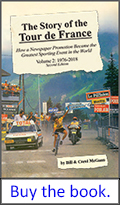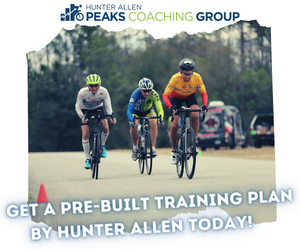

Team 7-Eleven and the 1986 Tour de France
By Owen Mulholland
Back to Rider Histories index page

Bill & Carol McGann's book The Story of the Tour de France, Vol 2: 1976 - 2018 is available as an audiobook here. For the print and Kindle eBook versions, just click on the Amazon link on the right.
The 7-Eleven cycling team started as an amateur squad in 1981 and turned into a pro outfit in 1985, gaining an invitation to ride the Giro d'Italia. At that Giro, 7-Eleven riders Andy Hampsten and Ron Kiefel won stages. That success led to 7-Eleven's getting to ride the 1986 Tour de France. Here's Owen's telling of those cycling-history-changing three weeks in July, written just after it had happened.
American saturation bombing of the 1986 Tour didn't end with Greg LeMond and Andy Hampsten. This year was also historic for the first entry of an American team, 7-Eleven. As surprising as their participation may have been to many Europeans, it had been envisioned by manager Jim Ochowicz for at least three years.

Andy Hampsten after winning stage 20 of the 1986 Giro d'Italia
But no one, not the Tour riders, the press, least of all the 7-Eleven riders themselves, anticipated their impact on the race the first week. Inspired by his excellent 21st place in the opening day prologue time trial, the Canadian member of 7-Eleven, Alex Stieda, blasted up the road early in the first real stage, from Nanterre to Sceaux. His ambitions were innocent enough, to get some TV time and grab some money in the intermediate sprints. While the nervous peloton of 210 riders (Stieda carried number 210) took time to get settled, Alex continued to carve out a lead.
After the first sprint, he explained, "I felt okay and no one was in sight behind me, so I kept going, taking the next two sprints. With 30 kilometers to go and a lead of two minutes [in this short 85-kilometer stage] I dreamed of staying away to the end. But a group of six caught me soon after and I was so wasted I lost all hope. That's when the Belgian, Pol Verschuere, told me, 'Work hard, because you have the yellow jersey.' I hadn't realized at all that the twelve second bonuses for each sprint had put me into first overall!"
It may have been a little untidy, but Alex wasn't complaining as he put on successively: the yellow jersey for overall time leader, the white jersey for best new Tour rider, the white-with-red-spots jersey for best climber, and the jersey composed of bits of all these colors for the best overall in all categories.
Reality dumped on 7-Eleven that afternoon in the 56-kilometer team time trial. Stieda hadn't recovered from his morning blowout so the others had to practically drag him along. In addition, four riders, including Alex, got flats, and Eric Heiden crashed. Talk about a fiasco. Every rider lost 5 minutes and 29 seconds, the time the team finished behind the winning Système U squad. (Système U had been inspired by their vendetta against Bernard Hinault who used to be their team leader three years ago.) Hinault, LeMond and company all lost 1 minute 55 seconds, so 7-Eleven wasn't alone in having wounds to lick. In a mere 1 hour 16 minutes and 42 seconds Stieda dropped from first to 94th!
Far from depressed, 7-Eleven was at battle stations the next day (stage three), a 214-kilometer jaunt from Levallois-Perret to Liéven. Eleven of these relatively flat stages across the north and west of France might strike observers as wastes of time. But there is constant action. Ron Kiefel, hardly a neophyte to the pro ranks, couldn't believe the intensity of these early stages. "The tempo was always high. Even when going easy, it still hurt. 53 x 15 and 14 were standard, and the 13 and 12-tooth cogs got a lot of use too."
It was glory hunters, like Davis Phinney, 7-Eleven's special sprint weapon, who kept the pot on full boil. During stage three he infiltrated a break at kilometer 137. Seventy-seven kilometers is a long way to be out front, even with eleven others to share the work, but Phinney is not one of those sprinters who sits behind a phalanx of teammates, and then pops through at the last moment. And anyway, 7-Eleven doesn't have the big displacement type guys who can lead out a sprinter for endless kilometers.
Davis quickly cased the group he was with. "I knew [Charly] Mottet and [Laurent] Biondi [both Système U boys] would want to control things, so I told myself, 'Be Cool'." (Translation: Let them chase down anyone who tries to get away.) The plan appeared to backfire when Spaniard Federico Echave took off and wasn't chased.
In the sprint Phinney moved slightly across the road in a subtle move to unnerve Henk Boeve and Robert Dill-Bundi. This tactic, along with his well known double-booster rockets, got him across the line first, for second...or so he thought until his victory was announced. Poor Echave had punctured and Davis was concentrating so intently on his place in the line he never saw Federico by the side of the road, wheel in hand.
Two days and a yellow jersey and a stage win! The 7-Eleven riders could all fall off their bikes and die and their mark on the Tour would have been made. But of course they did no such thing. Four days later (stage seven) Ron Kiefel joined three others in a chase of nearly 30 kilometers to catch an earlier break. Kiefel was the motor in his group, leaving his energy tank less than full for the sprint. His second place was a noble effort and went far to increasing respect for the team.
Enter the mountains and enter Alexi Grewal. Remember, he used to be considered a better climber than Hampsten. On the flat Alexi had been one of the masses residing at the back of the peloton and the bottom of the classification sheets. On the eve of the Pyrenees he sat in 184th place, eighth from the last, and tail end of his team. He had devoted himself to donkey work. Looking for a quick wheel to the front? Just ask Alexi. Need someone to send back for a teammate with a puncture? Grewal's there with a smile.
But that all ended when the road headed for the snows. On those two awesome Pyrenean stages where Hinault was crucifying 98% of the field, Grewal finished successively 16th and 12th. He also moved up 160 places on General Classification to 24th, which must have been some kind of record! For the first time in two years Alexi was showing his stuff, and he knew his best form was yet to come. Bring on the Alps!
The Pyrenees also claimed the first 7-Eleven victims, Doug Shapiro and Chris Carmichael. The bronchial virus making its rounds of the peloton had bitten these two at the worst time. Coughing and feverish, they struggled on these awesome climbs, but finally will power alone wasn't enough.
Tragically, Alexi was the next victim. The morning after the Pyrenees he awakened soigneur Shelly Verses at 4:30 a.m. "Shelly, I have a sore throat," he whispered. She did what she legally could, and so did Alexi. For two days he hung in, pedaling in a daze, but on the Alpine peaks where he'd hoped to really put on a show, he had to climb off. At age 26, almost a year older than Greg LeMond, he knows he won't have too many more opportunities to do what he knows he can.
All the 7-Eleven riders were on full hurt now. Their lack of big pre-Tour stage racing handicapped their ability to recover. For a man like Jeff Pierce with solid credentials as a climber it was especially galling to be struggling. "I could be going so much better," he lamented. "Such low placing are hard on the ego. One day I was positive I was dead, but after an hour I was thinking that so I knew I was alive."
Raul Alcala, the new Mexican recruit, who, if anything, was climbing better than Pierce back in the States, was now even worse off. He carried on stoically, suffering in silence to not only be the first of his countrymen to enter the Tour, but also to finish as well. Crashes eliminated Davis Phinney and Eric Heiden, the former breaking his wrist (he continued riding for hours before the pain became overwhelming) and the latter battering a guard rail with his head. Of all his team, Eric was the least natural for the Tour. His normal 180 pounds is too much to haul up those mountains, even with his physique. He reduced his body fat to close to 1%. The muscle striations in his butt were clearly visible through his tights. His crash came on the last big day in the Alps. He knew he was going to make it, then one missed turn and the goal of a lifetime slipped from his grasp.
Another new recruit for this year, Bob Roll, emerged as the best placed of the team. He lacked the glamorous palmarès of many on the 7-Eleven team, but his street fighter mentality and rugged rather than refined constitution saw him lead the team with a very meritorious final 63rd place.
Stieda proved to be a scrappy customer as well. He never let the first day glamour cloud his long term view. A rider most at home on the track and in criteriums, he showed what courage means. He was just hanging on most of the time, but that was more than the 40% who dropped out could do.
Towards the stage ends, when things were dragging, Alex lit up the peloton by whipping out his pocket camera and taking pictures. Another time he brought a water pistol and doused those who were lucky. (The heat was a big problem for many continentals).
This sense of fun pervaded the team. Everyone acknowledges Shelly's technical expertise, but as a morale booster she is priceless. By the end of the Tour she was the most loved person in the caravan. Skeptics became converts. Her encyclopedic memory gave that personal touch to her ability to crack jokes in four languages while hanging out a car window at 100 mph en route to a feed zone. The Tour is its own world and this sort of activity is normal among veteran support crews, but Shelly was the first femme to adjust to such conditions.
Probably her greatest coup was the day she bought a so-called porn magazine, tore out the best pictures, and put them in the riders' musettes along with their lunches. Ed Meese will probably never understand, but this one gesture went a long way toward gaining acceptance for the newest team in the peloton.
Shelly has had to walk a fine line being a woman in a man's world, and she has done it with such aplomb that one would never guess she was performing on a high wire. But she won't be alone in the future. Just as the press ranks were first cracked in 1975, giving rise to a small but growing pool of women reporters assigned to the Tour, so too has Shelly's performance given the green light to several potential colleagues around Europe.
In every way the 7-Eleven team has succeeded. The cycling world will never be the same.
Back to Rider Histories index page








